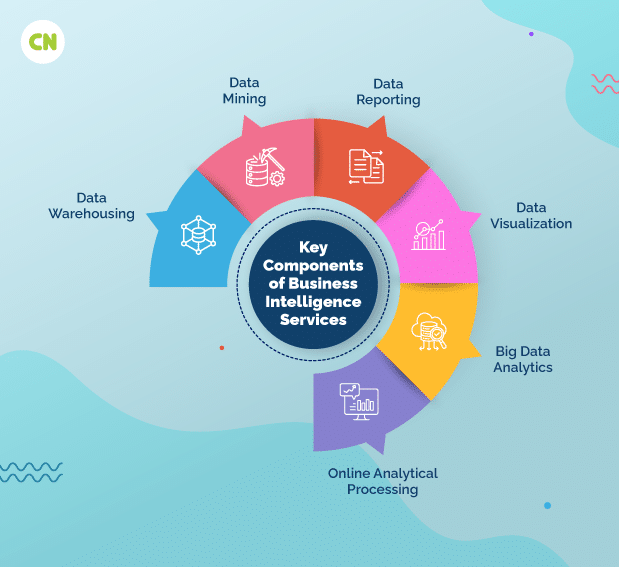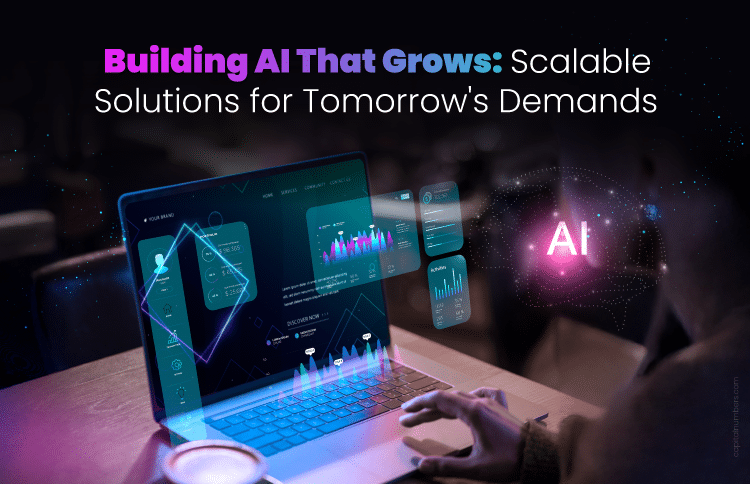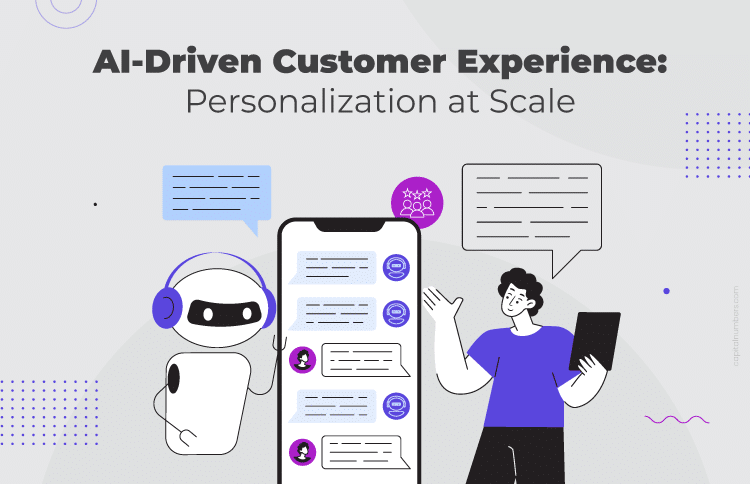A Comprehensive Guide to Business Intelligence Services for Non-Technical Leaders
Table of Contents
In today’s digital age, data is the foundation for businesses, offering invaluable insights that drive strategy, innovation, and competitive advantage. The ability to spot patterns and get actionable insights from vast datasets is essential for informed decision-making and long-term success. However, navigating the complexities of data to uncover valuable insights is not easy, especially for non-technical leaders. This is where Business Intelligence (BI) services play a key role. It transforms complex data into clear, actionable insights, enabling leaders to tackle the challenge of data-driven decision-making with confidence.
Also, incorporating data engineering services into BI initiatives ensures that data is accessible, prepared, and structured for meaningful analysis. This combination empowers leaders to leverage data effectively without needing deep technical expertise. Would you want to know about BI services for businesses in detail? Here, we will discuss all these that you need to know before incorporating BI services into your business model. So, without waiting any further, read on.
Understanding Business Intelligence
Business Intelligence (BI) refers to the technology-driven process used by organizations to analyze data and present actionable information. At its core, BI uses different tools, applications, and methodologies that enable organizations to collect data from internal IT systems and external sources. This data is then prepared for analysis, allowing for the development and execution of queries against it and the creation of reports. These outputs make analytical results available to decision-makers.
The role of BI in data-driven decision-making is vital for the success of modern businesses. BI systems offer historical, current, and predictive insights into business operations, often relying on data stored in a data warehouse or a data mart. At times, they may also use operational data to inform their analyses.
Besides, BI services are often paired with data analytics services to streamline the process of transforming raw data into strategic insights. This integration enhances data quality and accessibility, ensuring businesses can use their data effectively for informed decision-making. Through the use of BI tools, companies can improve their decision-making processes in several ways:
- Better Efficiency: By automating analytics, BI reduces the time and effort required for data processing. It allows decision-makers to focus on analyzing the results and making informed decisions rather than spending time gathering data.
- Accurate Insights: BI tools use advanced data analytics and visualization technologies. It can uncover hidden patterns and trends that may not be apparent through manual analysis. This leads to more accurate and insightful conclusions.
- Strategic Planning: BI assists companies in understanding their strengths and weaknesses by providing insights into their performance metrics. This understanding supports strategic planning by highlighting areas of improvement and opportunities for growth.
- Risk Management: By analyzing historical and current data, BI can help predict future trends, enabling businesses to anticipate and mitigate risks effectively.
- Competitive Advantage: BI gives companies access to essential information for their operations, providing a competitive advantage. This can be through a better understanding of their customers, more efficient operations, or insights into their competitors’ strategies.
Core Components of Business Intelligence Services

Business Intelligence (BI) is supported by several core components that are critical to its services. These work together to ensure that BI systems effectively assist businesses in making data-driven decisions:
- Data Warehousing: This is the component where large volumes of data from various sources are consolidated, transformed, and loaded into a single repository for more straightforward data analysis. Data warehouses store historical data, making it easier for businesses to analyze time series and historical safety references or to find new insights from past data.
- Data Mining: Data mining is a crucial aspect of Business Intelligence (BI). It involves analyzing large data sets to discover patterns, relationships, and new insights. This process helps uncover valuable information about market trends, customer behaviors, potential disruptions, and fraudulent activities, helping businesses make informed decisions.
- Data Reporting: Data reporting gathers important information in an easy-to-understand format. With the help of cutting-edge business intelligence software, decision-makers can create custom reports and visualizations, making complex data simple to understand and analyze. The goal is to provide a comprehensive report that answers users’ questions and helps make informed decisions.
- Data Visualization: Data visualization makes complex data easier to understand by presenting it in graphical formats. This method allows for quick insights and decision-making by displaying trends, patterns, and outliers in a visual context, whether it’s through web browsers or other digital platforms. It simplifies complex information, making it accessible across various digital environments.
- Big Data Analytics: Big data analytics is a vital part of BI services, examining large and complex data sets to uncover hidden patterns, unknown correlations, market trends, customer preferences, and other useful business information. It uses advanced analytic techniques on big data, which can come from various sources and in massive volumes that traditional BI tools might not handle well. This analysis helps businesses make more informed decisions, predict future trends, and understand their customers better. Big data analytics enables companies to sift through vast amounts of data to find insights that can lead to better decisions and strategic business moves.
- Online Analytical Processing: Online Analytical Processing (OLAP) is a key part of BI services that enables business leaders to analyze data for better decision-making thoroughly. This method allows for detailed BI reports, including trends, sales forecasts, financials, etc. OLAP enhances data analysis by offering a multi-dimensional view, like a 3D data perspective. This functionality permits interactive examination from various angles, letting businesses drill down into details, summarize (roll up), or shift (pivot) data views to gain deeper insights into their business metrics.
Benefits of Business Intelligence
Business Intelligence (BI) offers diverse benefits across various business functions, enhancing efficiency, decision-making, and strategic planning. Here’s how BI benefits key areas like finance, marketing, operations, and sales:
Finance
- Improved Financial Management: BI tools provide real-time data on financial performance, enabling more accurate forecasting, budgeting, and financial planning. It helps finance departments manage cash flow effectively and make informed investment decisions.
- Risk Management: By analyzing historical and current financial data, BI can help identify potential risks and opportunities, allowing for proactive risk management and strategic decision-making.
Marketing
- Customer Insights: BI tools analyze customer data to reveal buying patterns, preferences, and behaviors. It enables marketers to tailor their strategies, improve customer targeting, and enhance campaign effectiveness.
- ROI Measurement: Marketing departments can use BI to track the performance of marketing campaigns in real-time, measure ROI, and adjust strategies accordingly to maximize marketing spend.
Operations
- Efficiency Optimization: BI provides insights into operational processes, identifying bottlenecks and areas for improvement. This can lead to enhanced operational efficiency, reduced costs, and improved productivity.
- Supply Chain Management: By analyzing data across the supply chain, BI helps optimize inventory levels, forecast demand accurately, and improve delivery times, thus enhancing the overall supply chain efficiency.
Sales
- Sales Performance Analysis: BI tools enable sales teams to track performance against targets, analyze sales trends, and identify high-performing products or services. This information can be used to refine sales strategies and improve sales outcomes.
- Customer Relationship Management: BI enhances CRM by providing detailed insights into customer interactions, sales cycles, and customer satisfaction. This allows sales teams to build stronger customer relationships and improve customer retention rates.
Evaluating the ROI of Business Intelligence Solutions
Evaluating the potential Return on Investment (ROI) of Business Intelligence (BI) solutions involves a detailed cost-benefit analysis. This framework helps organizations assess whether the investment in BI technology will bring substantial returns. Here’s a simplified approach to conducting this analysis:
Investment
- Initial Investment: Includes the cost of BI software or platform, hardware, and any third-party services needed for implementation.
- Operational Costs: Ongoing expenses include software licenses, updates, maintenance, and support services.
- Training Costs: Expenses related to training staff to use the BI system effectively.
- Integration Costs: Costs associated with integrating the BI solution with existing systems and data sources.
Returns
- Increased Revenue: Estimate the potential increase in sales from improved data-driven decision-making and customer insights.
- Cost Savings: Identify areas where BI can streamline operations, reduce waste, or optimize resources, leading to direct cost savings.
- Efficiency Gains: Measure the time saved and the increase in productivity from automating reporting and analytics processes.
- Competitive Advantage: Qualitatively assess the value of improved market intelligence and the ability to respond quickly to industry changes.
Return on Investment
After assigning specific values to your Investments and Returns, you can calculate the ROI.
Real-world Examples of Businesses Using Business Intelligence Services
Let’s explore real-world examples showcasing how businesses leverage business intelligence to ensure data-driven decision-making, improve customer experiences, and more.
- Amazon: Amazon leverages BI tools to analyze customer behavior, preferences, and buying patterns. This data drives personalized recommendations, targeted marketing campaigns, and inventory management, enhancing customer experience and operational efficiency.
- Netflix: Netflix uses BI and data analytics to understand viewer preferences, watch times, and content performance. This intelligence drives their content creation decisions, recommendations algorithm, and marketing strategies, helping to retain and grow their subscriber base.
- Starbucks: Starbucks employs BI to analyze sales data, customer preferences, and market trends. This insight helps optimize product offerings, store locations, and marketing strategies, ensuring customer satisfaction and business growth.
- Uber: Uber uses BI to optimize its pricing model dynamically, analyze trip data for improving routes and customer service, and make strategic decisions about market expansions and partnerships.
- Coca-Cola: Coca-Cola uses BI tools to gather and analyze data from social media, retail points, and market trends to inform marketing campaigns, product development, and distribution strategies, ensuring they meet consumer demand effectively.
Frequently Asked Questions
1. Why is BI important for non-technical leaders?
BI empowers non-technical leaders with data-driven insights, enabling them to make informed decisions without deep technical expertise. It provides a clear overview of the business’s performance, trends, and opportunities.
2. How does business intelligence collect data?
Business Intelligence (BI) collects data by extracting it from various internal systems like ERP and CRM databases, and external sources such as market research and social media. It then integrates this information into a unified data warehouse or data lake for comprehensive analysis.
3. How does BI help in decision-making?
BI tools analyze and present data in an accessible format, such as reports, dashboards, and charts, helping leaders understand complex information quickly and make decisions based on factual evidence and trends.
4. How do I choose the right BI tool for my business?
Consider factors such as the specific needs of your business, ease of use, scalability, integration capabilities with existing systems, and cost. It may also be helpful to consult with a BI expert.
5. Can BI predict future trends?
Yes, through predictive analytics, a component of BI, businesses can forecast future trends, behaviors, and events based on historical data analysis. This helps in proactive decision-making and strategy development.
Final Thoughts
Business intelligence (BI) services are crucial for non-technical leaders aiming to guide their companies to success. BI simplifies complex data, enabling informed decision-making across various business sectors. It turns data into a valuable asset, helping leaders spot trends, improve operations, and increase customer satisfaction.
For organizations that want to thrive in today’s data-driven landscape, choosing a BI tool that aligns with their strategic goals is vital. Choosing BI equips leaders with actionable insights and cultivates a culture that values data-driven decisions.
As we look to the future, integrating BI into business strategies will be a defining factor in organizational success. For non-technical leaders, now is the time to embark on this journey, using BI to unlock potential, drive innovation, and secure a competitive edge in the evolving market.














